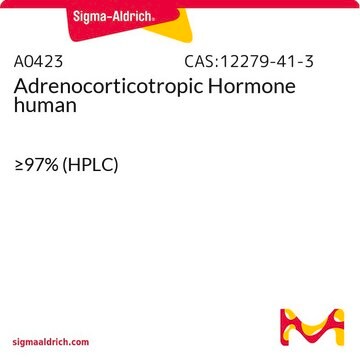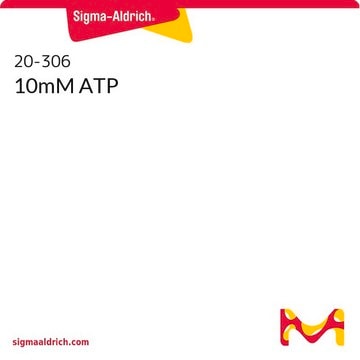Transportation information can be found in Section 14 of the product's (M)SDS.To access the shipping information for this material, use the link on the product detail page for the product.
A7699
Adénosine 5′-triphosphate disodium salt hydrate
BioXtra, ≥99% (HPLC), from microbial
Synonyme(s) :
ATP disodium salt
Sélectionner une taille de conditionnement
Sélectionner une taille de conditionnement
About This Item
Produits recommandés
Source biologique
microbial
Niveau de qualité
Gamme de produits
BioXtra
Pureté
≥99% (HPLC)
Forme
powder
Impuretés
≤0.1% inorganic P
≤3% solvent content
pKa
(1) 4.0, (2) 6.5
Solubilité
H2O: 50 mg/mL, clear, colorless
Traces d'anions
chloride (Cl-): ≤0.05%
Traces de cations
Al: ≤0.005%
Ca: ≤0.01%
Cu: ≤0.001%
Fe: ≤0.05%
K: ≤0.01%
Mg: ≤0.005%
NH4+: ≤0.05%
Pb: ≤0.001%
Zn: ≤0.0005%
λmax
259 nm
Température de stockage
−20°C
Chaîne SMILES
O.[Na+].[Na+].Nc1ncnc2n(cnc12)[C@@H]3O[C@H](COP(O)(=O)OP([O-])(=O)OP(O)([O-])=O)[C@@H](O)[C@H]3O
InChI
1S/C10H16N5O13P3.2Na.H2O/c11-8-5-9(13-2-12-8)15(3-14-5)10-7(17)6(16)4(26-10)1-25-30(21,22)28-31(23,24)27-29(18,19)20;;;/h2-4,6-7,10,16-17H,1H2,(H,21,22)(H,23,24)(H2,11,12,13)(H2,18,19,20);;;1H2/q;2*+1;/p-2/t4-,6-,7-,10-;;;/m1.../s1
Clé InChI
NTBQNWBHIXNPRU-MSQVLRTGSA-L
Vous recherchez des produits similaires ? Visite Guide de comparaison des produits
Application
Actions biochimiques/physiologiques
Vous ne trouvez pas le bon produit ?
Essayez notre Outil de sélection de produits.
Code de la classe de stockage
11 - Combustible Solids
Classe de danger pour l'eau (WGK)
WGK 2
Point d'éclair (°F)
Not applicable
Point d'éclair (°C)
Not applicable
Équipement de protection individuelle
Eyeshields, Faceshields, Gloves, type N95 (US)
Certificats d'analyse (COA)
Recherchez un Certificats d'analyse (COA) en saisissant le numéro de lot du produit. Les numéros de lot figurent sur l'étiquette du produit après les mots "Lot" ou "Batch".
Déjà en possession de ce produit ?
Retrouvez la documentation relative aux produits que vous avez récemment achetés dans la Bibliothèque de documents.
Les clients ont également consulté
Protocoles
ZIC®-cHILIC is a densely bonded zwitterionic stationary phase with phosphorylcholine functional groups covalently attached to silica.
HILIC separation is an alternative that permits sensitive MS detection and without the use of ion-pair reagents.
-
What is the Department of Transportation shipping information for this product?
1 answer-
Helpful?
-
-
What is the water content of Product A7699, Adenosine 5´-triphosphate disodium salt hydrate (ATP)? Does the formula weight listed on the website include water?
1 answer-
The formula weight on the website does not include water as the amount of water in the product will vary from lot to lot. The water content for any specific lot will be reported on the Certificate of Analysis for that lot.
Helpful?
-
-
What is the solubility of Product A7699, Adenosine 5´-triphosphate disodium salt hydrate (ATP)?
1 answer-
ATP disodium salt is soluble in water (50 mg/mL), yielding a clear, colorless solution. This solution is mildly acidic (pH approximately 3.5).
Helpful?
-
-
What is the stability of Product A7699, Adenosine 5´-triphosphate disodium salt hydrate (ATP), in solution?
1 answer-
Aqueous solutions of ATP are stable for months when frozen at -15°C and for approximately one week at 0°C. ADP is the first hydrolysis product formed, with additional hydrolysis leading to the formation of AMP. However, ATP solutions are only stable for several hours at 0 °C when dissolved in a trichloroacetic acid solution. In alkaline solution, it rapidly decomposes to inorganic pyrophosphate and adenosine 5'-phosphate even at 0 °C. This information can be found on the product information sheet (under Documents, above.
Helpful?
-
Active Filters
Notre équipe de scientifiques dispose d'une expérience dans tous les secteurs de la recherche, notamment en sciences de la vie, science des matériaux, synthèse chimique, chromatographie, analyse et dans de nombreux autres domaines..
Contacter notre Service technique










